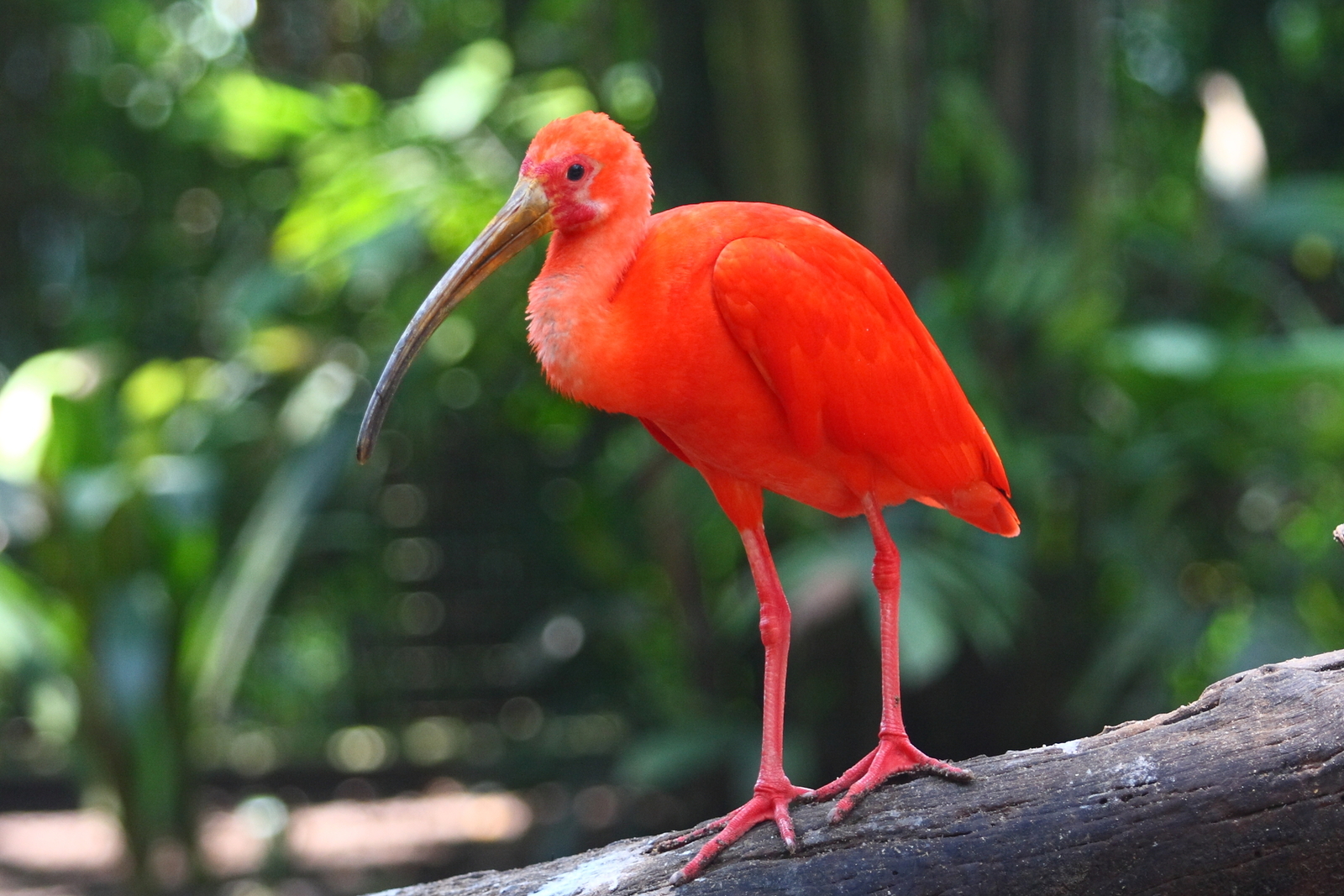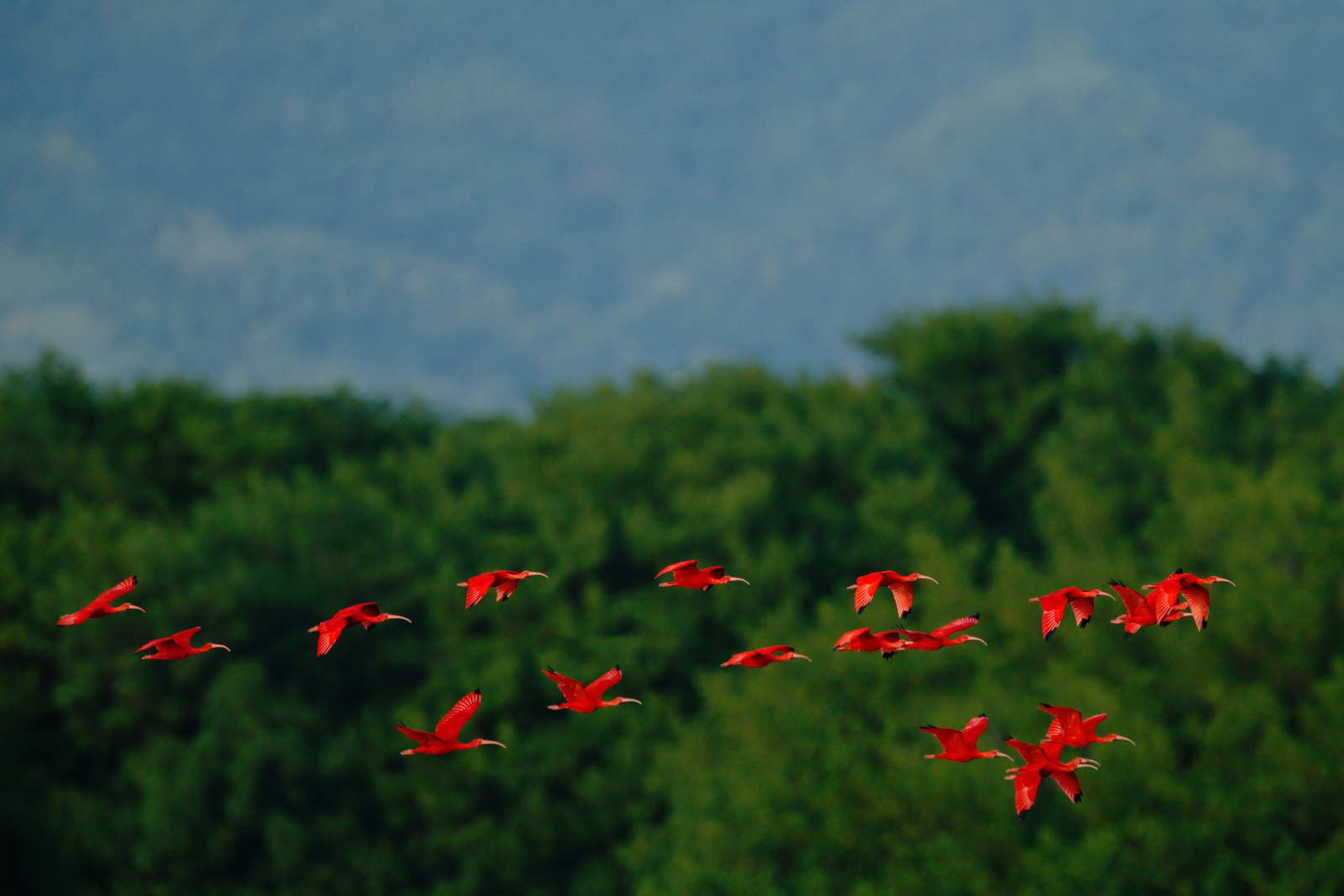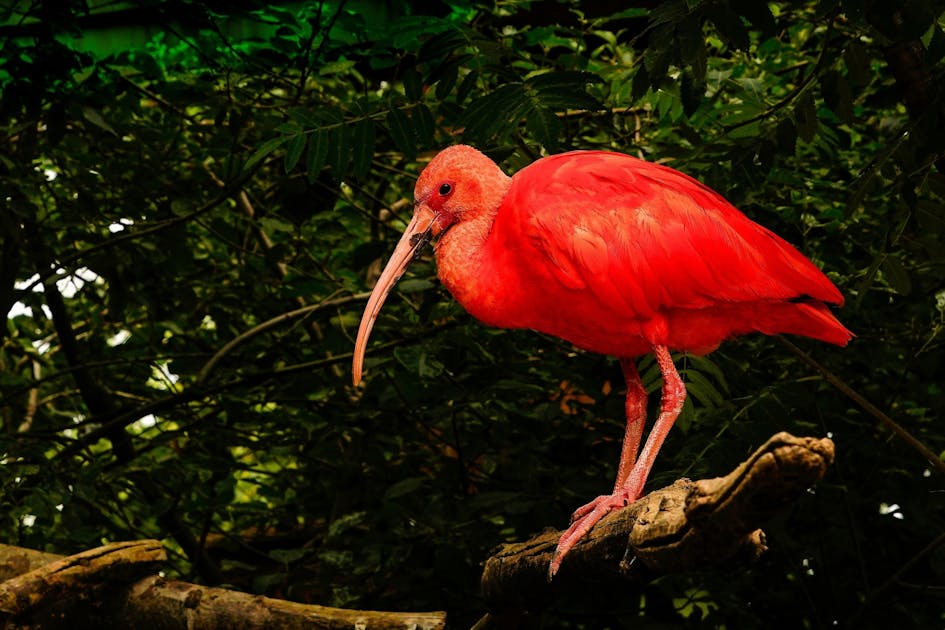Meet the scarlet ibis: The stunning bird of South America’s mangroves
One Earth’s “Species of the Week” series highlights an iconic species that represents the unique biogeography of each of the 185 bioregions of the Earth.
Among the 29 species of ibises in the Threskiornithidae family, the scarlet ibis (Eudocimus ruber) stands out with its breathtaking red plumage and expansive range. These vibrant birds grace the mangrove-lined coastlines of Colombia, Trinidad and Tobago, Venezuela, Guyana, Suriname, French Guiana, and Brazil.
For thousands of years, this region has been a biocultural territory of the Tupi People, who know the scarlet ibis as “Guará.” To the Tupi, the Guará is more than just a bird; it is a spiritual presence that deeply intertwines with their life and beyond.

The scarlet ibis (Eudocimus ruber) is the iconic species of the Amazon River Estuary bioregion (NT16), located in the Amazonia subrealm of Southern America.
Size and striking appearance
Adult scarlet ibises are relatively large birds within their coastal habitats, measuring between 55 and 63 centimeters (22–25 in) in length, with a wingspan of around 54 centimeters (21 in). Males are slightly larger than females and have bills that are, on average, 22% longer than those of females. Despite these differences, both sexes share the same vivid scarlet plumage with contrasting blue-black wingtips, creating a stunning display in flight.
Vibrant feathers due to a specialized diet
The brilliant red hue of the ibis’ feathers is directly linked to its diet, which is rich in pigments from fresh beach crustaceans. These birds spend their days foraging in shallow bays and estuary beaches, using their long beaks to probe the watery sand for food.
According to a study by Ffrench and Haverschmidt, their diverse diet includes brine water shrimps, mudflat insects, shield bugs, water beetles, frogs, mollusks, bivalves, small crabs like fiddler crabs, small snakes, snails, green algae, and fish.

A scarlet ibis on a tree branch. Image Credit:© Boaz Yunior Wibowo | Dreamstime.com.
Impact on its mangrove ecosystem
The ibis’ feeding habits play a crucial role in maintaining the health of coastal ecosystems. By consuming various prey that thrive in the mangrove root systems, these birds help regulate prey populations and contribute to the ecological balance of their habitats.
Mangrove corridors, composed of species like black mangrove (Avicennia nitida and Avicennia germinans), red mangrove (Rhizophora sp.), and white mangrove (Laguncularia racemosa), provide essential nurseries for these prey species and support a diverse food web.
Additionally, biologists have noted that while adult ibises primarily forage in saltwater or brackish-water swamps, they often shift to freshwater marshes, rice fields, and flooded savannas when feeding their young. This ensures that the chicks receive the nutrients they need for healthy development. Thus, the scarlet ibis helps maintain the ecological balance across different environments and highlights the bird’s adaptability and ecological significance.
Colony life and nesting habits
Scarlet ibises spend their adult lives roosting, parenting and feeding. Clustering in colonies with other ibis species and egrets, they fly between sweet water lagoons or mudflats and mangrove forests. Each colony develops distinctive habits in alternative patches of mangrove forest and even have different nesting strategies that make them unique to that ecosystem.
Despite their body weight, several couples will tend to use a single mangrove tree for multiple nests. These nests are built between 4.6 to 11 meters (15–35 ft) above the high tide. Red mangroves can host nests as high as 12 meters (39 ft) and as low as 2.4 meters (8 ft) above the high water, but there seems to be no set rule.
In Suriname, they nest in the black mangrove just 1.5 meters (5 ft) above the level of the high tide. Some nests are built on very sturdy bases within the mangrove thicket, whereas others are built at the fork of a naked branch, risking being taken down by winds and rains.

A flock of scarlet ibis, flying above the rainforest. Image Credit: © Ondřej Prosický | Dreamstime.com.
Breeding behavior and developmental stages
Scarlet ibises begin to breed soon after the onset of heavy rains, which varies between mid-April and mid to late September, depending on the coastal region and weather conditions on that year. Interestingly, they typically shift the peak nesting month and shift the nesting site within the swamp. But nesting does not happen simultaneously for all couples; rather, an observer can find nests with fresh eggs and birds already flying at the same time.
Clutch sizes vary. While nests in Suriname mostly have two eggs, those in Trinidad typically have three, although only two chicks tend to achieve fledging.
Juveniles take two years to become fully mature and leave their family. Their plumage during the juvenile phase is brown on the back and white in the belly, which reduces the chance of being detected by predators. Once they achieve maturity, they can live up to two decades.
Coexisting and neighboring species
In both Trinidad and Suriname, the Scarlet Ibis nests and roosts surrounded by herons, especially the little blue heron (Florida caerulea), the tricolored heron (Hydranassa tricolor), and the snowy egret (Egretta thula). In addition, smaller numbers of common egrets (Casmerodius alba), yellow-crowned night herons (Nyctanassa violacea), black-crowned night herons (Nycticorax nycticorax) and boat-billed herons (Cochlearius cochlearius) also associate with ibis colonies.
The cattle egret (Bubulcus ibis) arrived in 1951 in Trinidad and has since expanded and associated with scarlet ibis more than any other heron. In Suriname, reports in the 1980s said it was nesting with white-necked herons (Ardea cocoi) and roseate spoonbills (Ajaia ajaia).
Challenges and conservation efforts in Trinidad
On the western side of Trinidad, facing the Gulf of Paria, areas like the Caroni Swamp and Oropouche Swamp were once well-protected nesting sites for scarlet ibis colonies. A decree issued in 1953 ensured these colonies were safeguarded from disturbances, allowing the bird populations to thrive well into the 1980s.
However, in the past forty years, scarlet ibises have ceased breeding on the island, which is concerning given that the ibis is one of Trinidad and Tobago’s two national birds. This decline is likely due to several factors, including human disturbances from tourism, poaching, and fishing, chemical pollution from toxic effluents, and increased competition for nesting sites with the invasive cattle egret.
To combat these challenges, volunteer efforts to monitor scarlet ibis populations can play a crucial role. By preventing human disturbances during the first six weeks after hatching, volunteers can help ensure that the chicks develop fully before leaving their nests.
Additionally, local community members, in collaboration with scientists, can observe and report on the health, behavior, and habitat preferences of scarlet ibises and other associated species. This community-based approach can provide valuable insights into the ecological dynamics of these complex habitats, contributing to more effective conservation strategies.
.jpeg)
A member of the Enawenê Nawê displaying a vibrant featherwork headdress. Image Credit: Yves Picq, Wiki Commons.
Cultural significance and featherworking traditions of the Tupi Peoples
The Tupi Peoples thrived along the Atlantic coastline until the early 1500s, when Spanish colonizers disrupted their peaceful way of life. At that time, the Tupi population was nearly 700,000, coexisting harmoniously with the Guará and many other colorful birds.
The Tupi celebrated this vibrant avian presence, watching flocks fill the skies at dawn and seeing birds as sacred beings sent by celestial gods from higher realms. In their cosmovision, wearing feathers was believed to connect them to these divine beings and their ancestors.
Today, many Indigenous groups in the Amazon Basin continue these traditions through ceremonies that incorporate dance, music, and feathered attire, such as capes and headdresses. Featherworking is a highly specialized craft that goes beyond merely collecting feathers.
Birds like macaws are raised specifically for their feathers, and techniques such as ‘tapirage’ are used to alter the color of the feathers permanently. This involves treating the birds with natural substances to produce vibrant colors, while special diets further enhance the feathers’ beauty.
This intricate practice persists among isolated groups like the Tapiraré, a Tupi-speaking community near the middle course of the Araguaia River, and the Enawenê Nawê, who live between Brazil and Bolivia. Here, the birds are honored for their closeness to celestial deities, fostering a profound connection that endures beyond the lives of both the bird and the featherworker.
Continuing the legacy of the scarlet ibis
The scarlet ibis is not only a marvel of nature with its striking appearance and unique behaviors, but also a vital part of the cultural and ecological tapestry of the regions it inhabits. From their critical role in mangrove ecosystems to their deep spiritual significance among the Tupi Peoples, these birds embody a rich legacy that spans centuries.
As efforts to protect and preserve their habitats continue, the scarlet ibis remains a symbol of resilience and a reminder of the interconnectedness of life on Earth.

